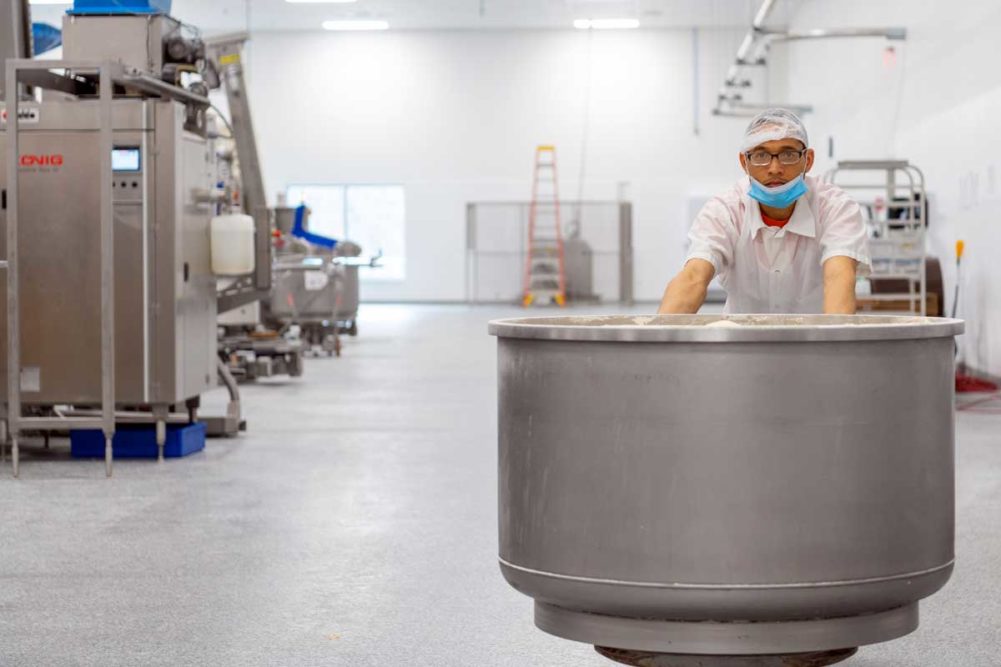Listen to the full story here or wherever you listen to podcasts:
With 200,000 square feet filled only to 20% capacity, Fireking Baking Co.’s new facility in Braintree, Mass., has a lot of breathing room. The oven room holds lots of opportunity for expansion. The adjacent boiler room houses two boilers for the two Miwe thermal deck ovens with room for one more. The boilers heat the oil and pump it to the ovens to heat the nine decks in each before oil is recirculated to the boiler to be heated again.
Fireking can add two more thermal deck ovens before needing to add a third boiler. During construction on the building, a 10-inch structure slab had to be installed into the floor to handle the ovens’ weight. When preparing for the ovens, Greg Acerra, founder and owner of Fireking, decided to pour a big enough slab to handle four more oven installations for the future.
The deck ovens bake off Fireking’s crusty breads: ciabatta; focaccia; oval breads like rye, country and sourdough; deck sub rolls; and hearth breads.
The rest of the room is populated with Koenig’s new Roto Passat rack ovens, 29 of them. The 30th lives in the new test kitchen. There is room for 70 rack ovens in total.
“The issue with rack ovens is space,” Mr. Acerra explained. “These are only 55 inches wide, and the burners are on the top. They are well-built and don’t need to be constructed onsite. They provide a great, consistent bake. A wider rack oven might have been able to only get 20 ovens in here. It’s a very efficient use of space.”
All this space, however, has a downside with operations only filling 20% of the building’s potential. There’s a lot of walking. Operators push racks significant distances to get from makeup to proofer to oven. But it’s a challenge
|
|
Mr. Acerra was willing to take on for the space to grow.
“These are the costs now, but the benefit is I can grow 500% in this facility,” he said. “It’s so expensive to build these facilities and move, so I built the biggest place I could afford.”
Jumping up to this level of production, one might expect Fireking to have invested in a tunnel oven, but Mr. Acerra said that isn’t what Fireking needs right now. With 250 products needing different temperatures and settings, flexibility and quality is his priority.
“Rack ovens have the flexibility to serve our customers,” he said. “We’re adapting the oven to our product instead of the other way around.”
Baked product is cooled in a separate room, a departure from the previous plant where baked product filled the space between ovens and packaging, heating up the entire bakery. Cool air is pumped and circulated throughout the room, creating a current to pull heat out of products. Eventually, Mr. Acerra hopes to install two spiral coolers with a conveyor feeding them product from above.
After finally cooling for 20 minutes to two hours, product enters the packaging department, which is as big as the previous bakery altogether.
“Packaging takes a lot of space,” Mr. Acerra said.
It also takes a lot of labor, and the majority of employees work in this department. Here, Mr. Acerra has ensured comfort in natural lighting from skylights and air conditioning for more ideal working conditions. Employees run seven packaging lines from UBE, Lematic, Bettendorf-Stanford, Ilapak and Formost Fuji, mostly baggers for rolls, buns and bread loaves. Crusty rolls are bulk packaged by an OK bulk packer. Three Robopac robot pallet wrappers cover pallets for distribution.
For the frozen business, the packaging room ends at two freezers, also custom-built by the engineering staff. The freezers can hold up to 1,100 pallets total. Another offsite freezer handles overflow. Product is frozen, packaged and then stored in the freezer before shipping out. There’s room for one more freezer in the future.
It’s also in this area of the new facility where the engineering room is, a large office space and shop that houses all the tools Fireking’s engineers and mechanics could need. As the business has grown, Mr. Acerra has also expanded his staff of engineers and mechanics and not just because the amount of equipment has proliferated.
“With smaller buildings, you just need mechanics for the equipment, but with a bigger building you need mechanics for the equipment and engineers for the building,” he explained.
After product is bagged, cartoned or palleted, it’s staged for pickup by distributors. Fireking will soon install a Dock Magic system to track and display shipment information. Here production starts all over again at ingredient receiving.
Between product staging and the makeup room is the pan wash room, where operators manage two pan washers from Douglas Machines Corp. Pans are scraped and washed after every bake and then returned to makeup. The pans that need to be oiled are sprayed in the adjacent room.
Fireking has maintained many of the same processes it had in place at the previous facility, just on a larger scale. Because its products contain allergens, each line is cleaned every night by a sanitation team that also makes notes of any maintenance that needs to be tended to and leaves a report for the mechanics in the morning. This process ensures that equipment is always running optimally and heads off any major break downs.
This article is an excerpt from the April 2020 issue of Baking & Snack. To read the entire feature on Fireking Baking Co., click here.






